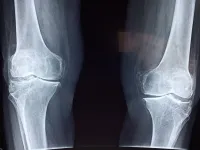(Press-News.org) Young Black women show a high prevalence of obesity, elevated blood pressure and other lifestyle-related factors that may put them on a trajectory to develop heart disease at a young age, according to a study presented at the American College of Cardiology's 70th Annual Scientific Session.
While previous research has drawn attention to the burden of heart disease among Black women, the new study is unique in its focus on examining the age at which heart disease risk factors emerge in this population in a community setting. The researchers found high rates of lifestyle-linked risk factors among Black women as early as their 20s and 30s.
"Young people should be the healthiest members of our population with normal body weight and normal blood pressure," said Nishant Vatsa, MD, an internal medicine resident at Emory University Hospital in Atlanta and the study's lead author. "We're finding obesity and elevated blood pressure are present in women even at younger ages, which is worrisome. Thus, interventions like educating young women about healthy dietary choices and the benefits of exercise, improving access to health care and enhancing the ability for people to adopt healthy practices--such as increasing access to healthy foods and safe areas for physical activity--needs to start early."
Vatsa and colleagues analyzed data collected in 2015-2018 from 945 Black women enrolled in a community health screening project in Atlanta. They assessed health markers such as body mass index (BMI), blood pressure and cholesterol levels; socioeconomic factors such as education, income and health insurance; and lifestyle factors such as smoking, diet and exercise.
The average BMI for women of all age groups was 30 or above, a level considered clinically obese. Systolic blood pressure levels, a measure of the force at which blood pushes against the artery walls during a heartbeat, increased with age. From ages 20-39 years, Black women had an average systolic blood pressure of 122 mmHg--higher than the 120 mmHg considered normal by the END
Cardiovascular risk factors appear early in Black women
Researchers call for preventive care and lifestyle changes among Black women under age 40
2021-05-05
ELSE PRESS RELEASES FROM THIS DATE:
New guidelines for schools recommend against food bans
2021-05-05
Hamilton, ON (May 5, 2021) - Schools and child care centres should train staff on food allergies and have epinephrine available to treat anaphylaxis, but new guidelines do not recommend food bans.
The recommendations come from an international team, led by McMaster University, which has developed practice guidelines for the prevention and management of allergic reactions to food at child care centres and schools. The guidelines were published today in the Journal of Allergy and Clinical Immunology.
"The management of food allergy is a sensitive topic," said Susan Waserman, ...
New MRI technique can detect early dysfunction of the blood-brain barrier with small vessel disease
2021-05-05
LEXINGTON, Ky. (May 5, 2021) - Collaborative research between the University of Kentucky (UK) and University of Southern California (USC) suggests that a noninvasive neuroimaging technique may index early-stage blood-brain barrier (BBB) dysfunction associated with small vessel disease (SVD). Cerebral SVD is the most common cause of vascular cognitive impairment, with a significant proportion of cases going on to develop dementia. BBB dysfunction represents a promising early marker of SVD because the BBB regulates a number of important metabolic functions, including clearance of toxic brain substances.
Advanced ...
One bone fracture increases risk for subsequent breaks in postmenopausal women
2021-05-05
Current guidelines for managing osteoporosis specifically call out hip or spine fractures for increasing the risk for subsequent bone breaks. But a new UCLA-led study suggests that fractures in the arm, wrist, leg and other parts of the body should also set off alarm bells.
A fracture, no matter the location, indicates a general tendency to break a bone in the future at a different location, said Dr. Carolyn Crandall, the study's lead author and a professor of medicine at the David Geffen School of Medicine at UCLA.
"Current clinical guidelines have only been emphasizing hip and spine fractures, but our findings challenge that viewpoint," Crandall said. "By not paying attention to which types of fractures increase the risk of future fractures, we are missing the opportunity to ...
New map reveals genes that control the skeleton
2021-05-05
Research led by the Garvan Institute of Medical Research has for the first time mapped the unique genetic profile of the skeleton's 'master regulator' cells, known as osteocytes.
The study published today in Nature Communications outlines the genes that are switched on or off in osteocytes, a type of bone cell that controls how other types of cells make or break down parts of the skeleton to maintain strong and healthy bones.
"This new information provides a kind of genetic shortlist we can look to when diagnosing bone diseases that have a genetic component," says the study's first author Dr Scott Youlten, Research Officer in the Bone Biology ...
Cryptic sense of orientation of bats localised: the sixth sense of mammals lies in the eye
2021-05-05
Mammals see with their eyes, hear with their ears and smell with their nose. But which sense or organ allows them to orient themselves on their migrations, which sometimes go far beyond their local foraging areas and therefore require an extended ability to navigate? Scientific experiments led by the Leibniz Institute for Zoo and Wildlife Research (Leibniz-IZW), published together with Prof. Richard A. Holland (Bangor University, UK) and Dr. Gunārs P?tersons (Latvia University of Life Sciences and Technologies) now show that the cornea of the eyes is the location of such an important sense in migrating bats. If the cornea is anaesthetised, the otherwise ...
New marker predicts benefit of radiotherapy for early-stage breast cancer
2021-05-05
A study involving researchers at Karolinska Institutet and Gothenburg University in Sweden has found that low levels of a protein called PDGFRb are associated with particularly good results of radiotherapy in women with early-stage breast cancer. The study, which is published in the journal Clinical Cancer Research, also suggests that the efficacy of radiotherapy can be improved with drugs that block this protein.
Some 900 women in Sweden are diagnosed with DCIS (ductalcarcinoma in situ), the earliest possible form of invasive breast cancer. Standard treatment is ...
Reduced kidney function linked to increased risk of dementia
2021-05-05
MINNEAPOLIS - Chronic kidney disease is when a person's kidneys progressively lose their ability to filter waste from the blood and eliminate fluids. Now a new study has found that people with reduced kidney function may have an increased risk of developing dementia. The study is published in the May 5, 2021, online issue of Neurology®, the medical journal of the American Academy of Neurology.
Chronic kidney disease affects approximately 15% of adults in the United States and it is more common as people age. However, since many people don't experience ...
Total knee replacement may be more painful for vitamin-D deficient postmenopausal women
2021-05-05
CLEVELAND, Ohio (May 5, 2021)--Vitamin D is a critical part of a healthy diet. Among other benefits, it has been shown to protect against bone disease and maintain soft tissue health. A new study suggests that it may also play a role in the degree of postoperative pain postmenopausal women experience after undergoing total knee replacement. Study results are published online today in Menopause, the journal of The North American Menopause Society (NAMS).
Vitamin D deficiency is a major issue globally. It is estimated that 60% of adults have insufficient levels of the bone-building vitamin. Estrogen deficiency in perimenopausal women has been associated with decreased levels of vitamin D. A sedentary lifestyle and lack of sun exposure have also been shown to contribute to vitamin D ...
Which medications are most toxic to the liver?
2021-05-05
A new study published in the British Journal of Clinical Pharmacology ¬provides insights on how common hospitalized patients develop liver injury from taking different medications.
When investigators analyzed the records of 156,570 hospitalized patients, they found 499 cases of drug-induced liver injury (DILI), for an incidence of 0.32%. Anti-infective agents, cancer medications, and nonsteroidal anti-inflammatory drugs were the major categories of drugs causing DILI, and the highest incidence was due to voriconazole (an antifungal medication). Patients with high cholesterol, cardiovascular disease, ...
Study uncovers potentially avoidable acute care use for vaccine-preventable illnesses in lupus patients
2021-05-05
A new study published in Arthritis Care & Research indicates that few individuals with the autoimmune disease lupus who were publicly insured through Medicaid received recommended vaccines in 2000-2010. Also, those who were unvaccinated needed more acute care for vaccine-preventable illnesses.
From 2000-2010, there were 1,290 patients who visited the emergency department or were hospitalized for vaccine-preventable illness, and 93% of these visits occurred in patients without billing codes for related vaccinations. Patients who were Black had a 22% higher risk of needing such care than those who were white.
"These episodes represent missed opportunities to deliver essential ...
LAST 30 PRESS RELEASES:
University of Oklahoma researcher awarded funding to pursue AI-powered material design
Exploring how the visual system recovers following injury
Support for parents with infants at pediatric check-ups leads to better reading and math skills in elementary school
Kids’ behavioral health is a growing share of family health costs
Day & night: Cancer disrupts the brain’s natural rhythm
COVID-19 vaccination significantly reduces risk to pregnant women and baby
The role of vaccination in maternal and perinatal outcomes associated with COVID-19 in pregnancy
Mayo Clinic smartwatch system helps parents shorten and defuse children's severe tantrums early
Behavioral health spending spikes to 40% of all children’s health expenditures, nearly doubling in a decade
Digital cognitive behavioral treatment for generalized anxiety disorder
Expenditures for pediatric behavioral health care over time and estimated family financial burden
Air conditioning in nursing homes and mortality during extreme heat
The Alps to lose a record number of glaciers in the next decade
What makes a good proton conductor?
New science reporting guide published for journalists in Bulgaria
New international study reveals major survival gaps among children with cancer
New science reporting guide published for journalists in Turkey
Scientists develop a smarter mRNA therapy that knows which cells to target
Neuroanatomy-informed brain–machine hybrid intelligence for robust acoustic target detection
Eight SwRI hydrogen projects funded by ENERGYWERX
The Lundquist Institute and its start-up company Vitalex Biosciences Announces Strategic Advancement of Second-Generation fungal Vaccine VXV-01 through Phase 1 Trials under $40 Million Competitive Con
Fine particles in pollution are associated with early signs of autoimmune disease
Review article | Towards a Global Ground-Based Earth Observatory (GGBEO): Leveraging existing systems and networks
Penn and UMich create world’s smallest programmable, autonomous robots
Cleveland researchers launch first major study to address ‘hidden performance killer’ in athletes
To connect across politics, try saying what you oppose
Modulating key interaction prevents virus from entering cells
Project explores barriers to NHS career progression facing international medical graduates
Jeonbuk National University researchers explore the impact of different seasonings on the flavor perception of Doenjang soup
Two Keck Medicine of USC Hospitals named Leapfrog Top Teaching Hospitals
[Press-News.org] Cardiovascular risk factors appear early in Black womenResearchers call for preventive care and lifestyle changes among Black women under age 40

